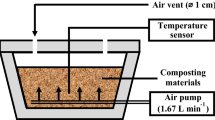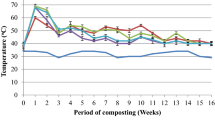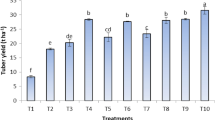Abstract
Reutilization of putrescible municipal solid wastes (MSW) in agriculture can provide valuable plant nutrients. However, it may pose serious noncarcinogenic health risks for a human when contaminants, especially the heavy metals in MSW, end up in plants through the waste-soil-plant continuum. This study examined the effects of composting methods viz. aerobically (AC), anaerobically (ANC), and aerobic-anaerobically (AANC) composted MSW material on (i) fertilizer value: vegetable yield, nitrogen (N) mineralization, and apparent N recovery (ANR); and (ii) associated health risks: selected heavy metal concentration, daily intake of metals (DIM), health risk index (HRI), hazard index (HI), and target hazard quotient (THQ) when applied to a loamy soil. All the aforementioned compost materials were incorporated into the sandy loam soil filled in pots and carrot and spinach were cultivated for 85 and 90 days, respectively. After soil application, between 51 and 56% of the applied organic N was mineralized from ANC material, while the values in case of AC and AANC were 26–31% and 34–40%, respectively. Consequently, dry matter yield and vegetable N uptake from composts were in the order ANC > AANC > AC (P < 0.05). Further, vegetable ANR was the highest from ANC (56 and 56%) than AANC (42 and 45%), and AC (30 and 33%) for spinach and carrot, respectively (P < 0.05). Interestingly, plant uptake of lead and cadmium was lowest from ANC as compared to AC or AANC (P < 0.05), irrespective of the vegetable type. Consequently, DIM, HRI, and THQ for these metals were substantially lower in the former as compared to the latter compost materials. Further, HI from ANC material was 50% lower over the unfertilized control indicating the absence of noncarcinogenic human health risks via vegetable intake. This all indicates that from viewpoint of sustainable waste recycling in agriculture, anaerobic composting is superior to the other composting methods.




Similar content being viewed by others
References
Abbasi AM, Iqbal J, Khan MA, Shah MH (2013) Health risk assessment and multivariate apportionment of trace metals in wild leafy vegetables from Lesser Himalayas, Pakistan. Ecotoxicol Environ Saf 92:237–244
Abbas T, Rizwan M, Ali S, Adrees M, Mahmood A, Rehman MZ, Ibrahim M, Arshad M, Qayyum M (2018) Biochar application increased the growth and yield and reduced cadmium in drought stressed wheat grown in an aged contaminated soil. Ecotoxicol Environ Safe 148:825–833
Achiba WB, Gabteni N, Lakhdar A, Laing GD, Verloo M, Jedidi N, Gallali T (2009) Effects of 5-year application of municipal solid waste compost on the distribution and mobility of heavy metals in a Tunisian calcareous soil. Agric Ecosyst Environ 130:156–163
Agusti AR, Seda M, Sarraga C, Montero JI, Castellari M, Muñoz P (2017) Municipal solid waste composting: application as a tomato fertilizer and its effect on crop yield, fruit quality and phenolic content. Renew Agri Food Syst 32:358–365
Ahmad I, Akhtar MJ, Zahir ZA, Mitter B (2015) Organic amendments: effects on cereals growth and cadmium remediation. Int J Environ Sci Technol 12:2919–2928
Ali B, Gill RA, Yang S, Gill MB, Ali S, Rafiq MT, Zhou W (2014a) Hydrogen sulfide alleviates cadmium-induced morpho-physiological and ultrastructural changes in Brassica napus. Ecotoxicol Environ Saf 110:197–207
Ali SM, Pervaiz A, Afzal B, Hamid N, Yasmin A (2014b) Open dumping of municipal solid waste and its hazardous impacts on soil and vegetation diversity at waste dumping sites of Islamabad city. J King Saud Univ Sci 26:59–65
Anwar S, Nawaz MF, Gul S, Rizwan M, Ali S, Kareem A (2016) Uptake and distribution of minerals and heavy metals in commonly grown leafy vegetable species irrigated with sewage water. Environ Monit Assess 188:1–9
Bar-Tal A, Yermiyahu U, Beraud J, Keinan M, Rosenberg R, Zohar D, Rosen V, Fine P (2004) Nitrogen, phosphorus, and potassium uptake by wheat and their distribution in soil following successive, annual compost applications. J Environ Qual 33:1855–1865
Bremner JM (1965) Organic nitrogen in soil. In: Bartholomew WV, Clark FE (eds) Soil nitrogen. Agronomy Monograph 10, Madison
Brown S, Chaney R, Hallfrisch J, Ryan JA, Berti WR (2004) In situ soil treatments to reduce the phyto-and bioavailability of lead, zinc, and cadmium. J Environ Qual 33:522–531
Carbonell G, de Imperial RM, Torrijos M, Delgado M, Rodriguez JA (2011) Effects of municipal solid waste compost and mineral fertilizer amendments on soil properties and heavy metals distribution in maize plants (Zea mays L.). Chemosphere 85:1614–1623
Chen Y, Cheng JJ, Creamer KS (2008) Inhibition of anaerobic digestion process: a review. Bioresour Technol 99:4044–4066
Civeira G (2010) Influence of municipal solid waste compost on soil properties and plant reestablishment in peri-urban environments. Chil J Agri Res 70:446–453
Diaz E, Roldln A, Lax A, Albaladejo J (1994) Formation of stable aggregates in degraded soil by amendment with urban refuse and peat. Geoderma 63:277–288
Estefan G, Sommer R, Ryan J (2013) Methods of soil, plant, and water analysis: a manual for the west, Asia and North Africa region. ICARDA, Beirut
Gigliotti G, Businelli D, Giusquiani PL (1996) Trace metals uptake and distribution in corn plants grown on a 6-year urban waste compost amended soil. Agric Ecosyst Environ 58:199–206
Gill RA, Zhang N, Ali B, Farooq MA, Xu J, Gill MB, Mao B, Zhou W (2016) Role of exogenous salicylic acid in regulating physio-morphic and molecular changes under chromium toxicity in black-and yellow-seeded Brassica napus L. Environ Sci Pollut Res 23:20483–20496
Giusti L (2009) A review of waste management practices and their impact on human health. Waste Manag 29:2227–2239
Guerrero LA, Maas G, Hogland W (2013) Solid waste management challenges for cities in developing countries. Waste Manag 33:220–232
Hargreaves JC, Adl M, Warman PR, Rupasinghe H (2008a) The effects of organic and conventional nutrient amendments on strawberry cultivation: fruit yield and quality. J Sci Food Agric 88:2669–2675
Hargreaves JC, Adl MS, Warman PR (2008b) A review of the use of composted municipal solid waste in agriculture. Agric Ecosyst Environ 123:1–14
Jabeen N, Abbas Z, Iqbal M, Rizwan M, Jabbar A, Farid M, Ali S, Ibrahim M, Abbas F (2016) Glycinebetaine mediates chromium tolerance in mung bean through lowering of Cr uptake and improved antioxidant system. Arch Agron Soil Sci 62:648–662
Jenkinson DS, Tinsley J (1959) Studies on the organic material extracted from soil and composts. 1. The isolation and characterisation of ligno-proteins from composts. J Soil Sci 10:245–263
Khalid S, Shahid M, Dumat C, Niazi NK, Bibi I, Bakhat HFS, Abbas G, Murtaza B, Javeed HMR (2017) Influence of groundwater and wastewater irrigation on lead accumulation in soil and vegetables: implications for health risk assessment and phytoremediation. Int J Phytoremediaton. https://doi.org/10.1080/15226514.2017.1319330
Kirchmann H, Bernal MP (1997) Organic waste treatment and C stabilization efficiency. Soil Biol Biochem 29:1747–1753
Maftoun M, Moshiri F, Karimian N, Ronaghi A (2005) Effects of two organic wastes in combination with phosphorus on growth and chemical composition of spinach and soil properties. J Plant Nutr 27:1635–1651
Mahfooz SA, Saghir A, Ashar A (2006) Composting: a unique solution to animal waste management. J Agri Soc Sci 1:38–41
Mahmood A, Malik RN (2014) Human health risk assessment of heavy metals via consumption of contaminated vegetables collected from different irrigation sources in Lahore, Pakistan. Arab J Chem 7:91–99
Masunga RH, Uzokwe VN, Mlay PD, Odeh I, Singh A, Buchan D, De Neve S (2016) Nitrogen mineralization dynamics of different valuable organic amendments commonly used in agriculture. Appl Soil Ecol 101:185–193
Mmereki D, Baldwin A, Li B (2016) A comparative analysis of solid waste management in developed, developing and lesser developed countries. Environ Technol Rev 5:120–141
Mosier A, Doran J, Freney J (2002) Managing soil denitrification. J Soil Water Conserv 57:505–512
Murray H, Pinchin TA, Macfie SM (2011) Compost application affects metal uptake in plants grown in urban garden soils and potential human health risk. J Soils Sediments 11:815–829
Perrot JF, Subiantoro A (2018) Municipal waste management strategy review and waste-to-energy potentials in New Zealand. Sustain. https://doi.org/10.3390/su10093114
Rehman RA, Rizwan M, Qayyum MF, Ali S, Zia-ur-Rehman M, Zafar-ul-Hye M, Hafeez F, Iqbal MF (2018) Efficiency of various sewage sludges and their biochars in improving selected soil properties and growth of wheat (Triticum aestivum). J Environ Manag 223:607–613
Rizwan M, Ali S, Abbas T, Rehman MZ, Hannan F, Keller C, Al-Wabel MI, Ok YS (2016) Cadmium minimization in wheat: a critical review. Ecotoxicol Environ Saf 130:43–53
Rizwan M, Ali S, Adrees M, Ibrahim M, Tsang DC, Rehman MZ, Zahir ZA, Rinklebe J, Tack FM, Ok YS (2017) A critical review on effects, tolerance mechanisms and management of cadmium in vegetables. Chemosphere 182:90–105
Rizwan M, Ali S, ur Rehman MZ, Rinklebe J, Tsang DC, Bashir A, Maqbool A, Tack FM, Ok YS (2018) Cadmium phytoremediation potential of Brassica crop species: a review. Sci Total Environ 631:1175–1191
Shah GM, Shah GA, Groot JCJ, Oenema O, Lantinga EA (2012) Irrigation and lava meal use reduce ammonia emission and improve N utilization when solid cattle manure is applied to grassland. Agric Ecosyst Environ 160:59–65
Shah GM, Rashid MI, Shah GA, Groot JCJ, Lantinga EA (2013) Mineralization and herbage recovery of animal manure nitrogen after application to various soil types. Plant Soil 365:69–79
Shah GM, Shah GA, Groot JC, Oenema O, Raza AS, Lantinga EA (2016a) Effect of storage conditions on losses and crop utilization of nitrogen from solid cattle manure. J Agric Sci 154:58–71
Shah GM, Shah GA, Groot JCJ, Raza MAS, Shahid N, Lantinga EA (2016b) Nitrogen recovery and dry matter production of silage maize as affected by the application of solid cattle manure stored under different conditions. J Soil Sci Plant Nutr 16:591–603
Shah GM, Tufail N, Rashid MI, Imran M, Murtaza B, Saeed F, Farooq MAU, Bakhat HF (2017) Anaerobic degradation of municipal organic waste among others composting techniques improves N cycling through waste-soil-plant continuum. J Soil Sci Plant Nutr 17:529–542
Sing M, Verma M, Kumar M (2018) Effects of open dumping of MSW on metal contamination of soil, plants, and earthworms in Ranchi, Jharkhand, India. Environ Monit Assess. https://doi.org/10.1007/s10661-018-6492-y
Smith SR (2009) A critical review of the bioavailability and impacts of heavy metals in municipal solid waste composts compared to sewage sludge. Environ Int 35:142–156
Thanh PM, Ketheesan B, Yan Z, Stuckey D (2016) Trace metal speciation and bioavailability in anaerobic digestion: a review. Biotechnol Adv 34:122–136
United States Environmental Protection Agency (US EPA) (2000) Risk-based concentration table. US EPA, Washington D. C
Uriah LA, Shehu U (2014) Environmental risk assessment of heavy metals content of municipal solid waste used as organic fertilizer in vegetable gardens on the Jos plateau, Nigeria. Am J Environ Prot 3:1–13
USEPA (2006) USEPA region III risk-based concentration table: technical back-ground information. Unites States Environmental Protection Agency, Washington
Walter I, Martínez F, Cuevas G (2006) Plant and soil responses to the application of composted MSW in a degraded, semiarid shrubland in central Spain. Compost Sci Util 14:147–154
Wang Y, Qiao M, Liu Y, Zhu Y (2012) Health risk assessment of heavy metals in soils and vegetables from wastewater irrigated area, Beijing-Tianjin city cluster, China. J Environ Sci 24:690–698
Waqar A, Shah GM, Bakhat HF, Aslam M, Ashraf MR, Shahid M, Hafeez R, Murtaza B, Rashid MI (2019) Anecic earthworm Pheretima hawayana affects CO2 emission and maize N recovery from soil-applied organic wastes. Eur J Soil Biol 90:1–8
Warman P, Burnham J, Eaton L (2009) Effects of repeated applications of municipal solid waste compost and fertilizers to three lowbush blueberry fields. Sci Hortic 122:393–398
Weber J, Kocowicz A, Bekier J, Jamroz E, Tyszka R, Debicka M, Parylak D, Kordas L (2014) The effect of a sandy soil amendment with municipal solid waste (MSW) compost on nitrogen uptake efficiency by plants. Eur J Agron 54:54–60
Zeng X, Wang Z, Wang J, Guo J, Chen X, Zhuang J (2015) Health risk assessment of heavy metals via dietary intake of wheat grown in Tianjin sewage irrigation area. Ecotoxicol 24:2115–2124
Zheng N, Wang Q, Zhang X, Zheng D, Zhang Z, Zhang S (2007) Population health risk due to dietary intake of heavy metals in the industrial area of Huludao city, China. Sci Total Environ 387:96–104
Zhou J, Zhang Z, Zhang Y, Wei Y, Jiang Z (2018) Effects of lead stress on the growth, physiology, and cellular structure of privet seedlings. PLoS One 13:1–14. https://doi.org/10.1371/journal.pone.0191139
Acknowledgements
We are equally indebted to COMSATS University Islamabad, Vehari-Campus for proving technical support and assistance in executing this study. We thank Rao Rashid, Sana Khalid, and Muhammad Kamran for help in the field and laboratory work. Special thanks are due to Prof (Rtd.) Dr. Muhammad Aslam for English proofreading of the manuscript.
Funding
This work was partially financed by the Higher Education Commission (HEC), Pakistan under a start-up research grant program (#21-143/SRGP/R&D/HEC/2014).
Author information
Authors and Affiliations
Corresponding author
Additional information
Responsible editor: Philippe Garrigues
Publisher’s Note
Springer Nature remains neutral with regard to jurisdictional claims in published maps and institutional affiliations.
Rights and permissions
About this article
Cite this article
Shah, G.M., Tufail, N., Bakhat, H.F. et al. Composting of municipal solid waste by different methods improved the growth of vegetables and reduced the health risks of cadmium and lead. Environ Sci Pollut Res 26, 5463–5474 (2019). https://doi.org/10.1007/s11356-018-04068-z
Received:
Accepted:
Published:
Issue Date:
DOI: https://doi.org/10.1007/s11356-018-04068-z




